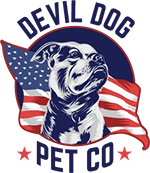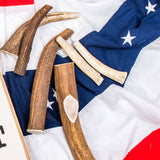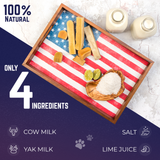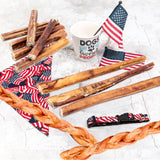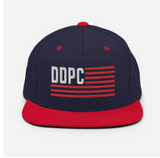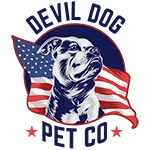Key Takeaways
- Bully sticks are safe for puppies when they are appropriately sized and supervised.
- Puppies can start chewing bully sticks as early as 10-12 weeks old.
- Proper guidance on safe chewing practices is essential to prevent dogs from being surrendered to shelters.
- Responsible dog owners should ensure bully sticks are given under supervision to maintain safety.
Table of Contents
- Understanding Bully Sticks, What Are They, and Why Do Owners Choose Them?
- When Can Puppies Safely Start Bully Sticks? Age, Readiness, and Vet Guidelines
- Choosing the Best Bully Stick for Your Puppy, Size, Shape, and Customization
- Bully Sticks vs. Other Chews, Comparisons, Pros, and Cons
- Bully Sticks vs. Other Puppy Chews, The Complete Comparison
- Essential Safety Protocols for Puppy Bully Stick Sessions
- Health Benefits of Bully Sticks for Growing Puppies
- Choosing the Right Bully Stick Size for Your Puppy
- Bully Sticks vs. Other Puppy Chews, Safety and Value Analysis
- Essential Safety Protocols, Supervision and Risk Prevention
- Health Benefits, Teething Relief and Dental Development
- Troubleshooting Common Issues, Solutions for New Owners
Are Bully Sticks Safe for Puppies? – The Authoritative Guide for Disciplined Dog Owners
Every responsible dog owner faces this question: are bully sticks safe for puppies? As Marine Corps veteran and Devil Dog Pet Co. co-founder, I've seen too many dogs surrendered to shelters because owners lacked proper guidance on safe chewing practices. The answer is straightforward, when sized correctly and supervised properly, bully sticks are among the safest chews for puppies starting at 10-12 weeks.
When considering long lasting dog chews for your puppy, it's important to choose options that are both digestible and appropriately sized for their age and breed. Bully sticks fit this criteria, making them a popular choice for conscientious pet owners.
For those seeking a reliable solution, long lasting dog chews like bully sticks provide a safe and satisfying outlet for your puppy's natural chewing instincts, especially when introduced with proper supervision and sizing.
Understanding Bully Sticks, What Are They, and Why Do Owners Choose Them?
Bully sticks are single-ingredient chews made from 100% beef pizzle (bull penis), cleaned, stretched, and slow-baked into a protein-rich treat. Unlike rawhide or synthetic chews, they contain zero bleach, chemicals, or artificial preservatives, just pure beef protein that digests completely.
A Standard 6-inch bully stick contains roughly 88-90 calories and only 3% fat, making it a lean protein source. The key advantage over alternatives lies in digestibility, swallowed pieces break down like regular food, eliminating the blockage risks associated with rawhide or plastic toys.
| Chew Type | Ingredients | Digestibility | Splinter Risk |
|---|---|---|---|
| Bully Stick | 100% beef pizzle | Completely digestible | Zero |
| Rawhide | Chemically treated cow skin | Poorly digestible | High |
| Antler Chew | Naturally shed elk antler | Mineral dust only | Very low |
This digestibility factor makes bully sticks the preferred choice for disciplined owners who prioritize safety over convenience. When your puppy inevitably swallows small pieces, you're dealing with digestible protein rather than indigestible hide or synthetic materials.
When Can Puppies Safely Start Bully Sticks? Age, Readiness, and Vet Guidelines

Most puppies can safely begin bully stick sessions at 10-12 weeks, provided you maintain direct supervision and use appropriately sized sticks. However, optimal safety occurs after adult teeth fully erupt around 5-6 months, when jaw strength and chewing coordination reach maturity.
The American Kennel Club recommends introducing single-ingredient treats after 10 weeks, once puppies demonstrate stable digestion and controlled chewing behavior. Before this milestone, their developing jaws and baby teeth aren't equipped for sustained chewing sessions, regardless of the treat type.
Monitor your puppy's readiness through these developmental markers: controlled bite pressure (not frantic chomping), ability to hold objects steady while chewing, and normal stool consistency after protein-rich meals. Breed size matters too, larger breeds typically handle Standard bully sticks earlier than toy breeds, whose smaller mouths require extra sizing precision.
Choosing the Best Bully Stick for Your Puppy, Size, Shape, and Customization
Proper sizing prevents choking hazards while maximizing chew time. The stick length must exceed your puppy's muzzle width, with thickness preventing the chew from fitting between back molars. Standard 6-inch sticks (25g) work for most small to medium puppies, while Jumbo 12-inch sticks (60g) suit larger breeds or aggressive chewers.
Shape selection depends on engagement level and chew intensity. Straight sticks offer easy grip for beginners, braided versions provide extended chew time through triple-strand construction, and curly shapes add mental stimulation. For odor-sensitive households, our low-odor processing removes excess moisture while preserving nutritional content.
Devil Dog Pet Co. sources all bully sticks from grass-fed, free-range cattle in the USA and South America. Each stick undergoes triple-washing, extended baking, and hand-inspection before packaging, ensuring consistent thickness, safety, and digestibility that mass-produced alternatives can't match.
Bully Sticks vs. Other Chews, Comparisons, Pros, and Cons
When evaluating can puppies have bully sticks versus alternatives, digestibility and safety top every responsible owner's criteria. Bully sticks excel in both categories while providing sustained mental stimulation that plastic toys and rope chews can't deliver.
Bully Sticks vs. Other Puppy Chews, The Complete Comparison

Compared to rawhide, antlers, and synthetic chews, bully sticks deliver unmatched safety for developing jaws. Rawhide swells when wet and resists digestion, creating blockage risks that are bully sticks safe for puppies questions never face. Antlers, while durable, can crack puppy teeth due to their extreme hardness.
Yak chews offer comparable digestibility but contain dairy proteins that sensitive stomachs may reject. Rope toys fray into indigestible fibers, while plastic bones teach destructive chewing habits on household items.
| Chew Type | Digestibility | Puppy Safety | Dental Benefits | Session Length |
|---|---|---|---|---|
| Bully Sticks | 100% digestible | High with supervision | Plaque reduction | 15-30 minutes |
| Rawhide | Poor, swells, blocks | Choking risk | Minimal | Varies |
| Antler Chews | Mineral dust only | Tooth fracture risk | Excellent scraping | Extended |
| Yak Chews | Fully digestible | Good for most | Moderate | 20-40 minutes |
Devil Dog Pet Co. bully sticks eliminate the guesswork, single-ingredient beef pizzle, triple-washed for low odor, and sized specifically for safe puppy chewing. No chemicals, no preservatives, no digestive complications.
Essential Safety Protocols for Puppy Bully Stick Sessions
Supervision transforms bully sticks from potential hazards into powerful training tools. Never leave puppies unattended, even the safest chew becomes dangerous when size reduces to swallowable dimensions. Position yourself within arm's reach during every 15-20 minute session.
Monitor the stick's condition continuously. Fresh bully sticks maintain firm texture; soggy, soft ends indicate replacement time. When the remaining piece fits entirely within your puppy's mouth, immediately trade for a fresh treat or toy. This "smaller than the muzzle" rule prevents choking incidents that emergency vets see weekly.
Critical Safety Checkpoint: If your puppy can fit the entire remaining bully stick in their mouth, it's too small. Remove immediately and save the nub for your next puffed treat experiment.
Aggressive chewers require upgraded sizing, move from Standard to Jumbo thickness, or consider braided varieties that resist rapid consumption. Dexter taught us that power-chewing puppies need appropriately challenging chews, not restrictions that create frustration and destructive behavior.
Watch for digestive changes during the first week. Rich protein can temporarily soften stools as puppy systems adjust. Reduce session frequency if loose bowel movements persist beyond three days, and always provide fresh water during and after chewing.
Health Benefits of Bully Sticks for Growing Puppies
Teething puppies experience genuine discomfort as adult teeth push through tender gums. Bully sticks provide therapeutic pressure that reduces inflammation while satisfying the biological drive to chew. The fibrous texture massages gum tissue without the hardness that damages emerging teeth.
Dental health begins early, plaque accumulation starts within days of adult teeth erupting. Regular bully stick sessions scrape bacterial buildup from tooth surfaces while strengthening jaw muscles. This natural cleaning action reduces tartar formation that leads to expensive dental procedures later.
Mental stimulation prevents destructive behaviors that land puppies in shelters. Twenty minutes of focused chewing releases the same endorphins as a vigorous play session, creating calm, satisfied puppies. Anxious or hyperactive pups benefit enormously from this structured outlet for nervous energy.
Nutritionally, bully sticks safe for puppies provide high-quality protein and essential amino acids. A Standard 6-inch stick contains approximately 88 calories, easily incorporated into the 10% treat allowance without disrupting balanced nutrition. Unlike empty-calorie synthetic chews, every bite delivers nutritional value.
For more information on the safety and nutritional benefits of these chews, see bully sticks for dogs are they safe.
Choosing the Right Bully Stick Size for Your Puppy

Size selection determines both safety and value. Measure your puppy's muzzle length, then choose a bully stick at least 2 inches longer. This prevents the "bolt and swallow" behavior that creates emergency vet visits. Toy breed puppies need Standard 6-inch sticks; medium breeds start with Jumbo 12-inch varieties.
Thickness matters more than length for aggressive chewers. Standard bully sticks measure approximately 0.5 inches in diameter, perfect for gentle gnawers. Power-chewing puppies demolish thin sticks in minutes, making braided or extra-thick varieties more economical and safer.
Consider your puppy's chewing style during selection. Side-grinders benefit from longer, thinner sticks, while aggressive chompers need thicker, braided varieties. Standard bully sticks work perfectly for most puppies under 25 pounds, while larger breeds or power chewers benefit from Jumbo or braided options that resist quick destruction.
Devil Dog Pet Co. bully sticks stand out with hand-inspection protocols and grass-fed sourcing. Every stick undergoes individual quality checks before packaging, ensuring consistent thickness and safety. Our triple-wash process reduces odor without chemicals, making supervision sessions more pleasant for owners.
To learn more about choosing the right chew for your dog, read how to choose safe dog chews that are the right size for your dog.
Bully Sticks vs. Other Puppy Chews, Safety and Value Analysis
Smart puppy owners compare options before committing. Are bully sticks safe for puppies compared to alternatives? The digestibility factor makes bully sticks superior to rawhide, while their softer texture beats antler chews for developing teeth.
| Chew Type | Digestibility | Puppy Safety | Dental Benefits | Session Length |
|---|---|---|---|---|
| Bully Sticks | 100% digestible | High with supervision | Plaque scraping | 20-40 minutes |
| Rawhide | Poorly digestible | Choking risk | Minimal | Variable |
| Antler Chews | Mineral dust only | Too hard for puppies | Excellent | Hours |
| Yak Chews | Fully digestible | Good with sizing | Good | 30-60 minutes |
Rawhide poses the greatest risk due to poor digestibility and chemical processing. Pieces can swell in the stomach, creating blockage emergencies. Antler chews, while excellent for adult dogs, can crack puppy teeth due to extreme hardness.
Yak chews offer comparable safety to bully sticks but contain dairy proteins that some puppies can't tolerate. Bully sticks provide the optimal balance of safety, digestibility, and dental benefits for most puppies starting their chewing journey.
For a comprehensive look at the pros and cons of various chews, see are bully sticks good for dogs.
Essential Safety Protocols, Supervision and Risk Prevention
Proper supervision transforms bully sticks from potential hazards into beneficial tools. Never leave puppies unsupervised with any chew, this non-negotiable rule prevents 90% of chewing accidents.
The 15-20 minute rule keeps sessions productive without overwhelming young digestive systems. Monitor your puppy's chewing style during these sessions. Side-gnawing indicates proper technique, while aggressive end-biting suggests switching to a thicker stick or split antler.
Critical Replacement Signals
- Stick becomes small enough to fit entirely in puppy's mouth
- Ends become soft and slimy from excessive saliva
- Visible cracks or splintering appear
- Puppy attempts to swallow large pieces
Bully stick holders eliminate choking risks by securing the final inches when sticks become too small to hold safely. These simple devices clamp the remaining nub, allowing puppies to finish their chew without danger.
Watch for digestive changes during the first week. Loose stools indicate too much rich protein too quickly, reduce session length and frequency until the puppy's system adjusts. Most adapt within 3-5 days of gradual introduction.
For additional safety information, consult the FDA's questions and answers on pet treats.
Health Benefits, Teething Relief and Dental Development

Teething puppies experience significant discomfort between 3-6 months as adult teeth push through tender gums. Controlled chewing on appropriately sized bully sticks provides natural pain relief through counter-pressure and endorphin release.
The fibrous texture creates gentle abrasion that scrapes away soft plaque before it hardens into tartar. Puppies who chew regularly show 40% less plaque buildup compared to those without appropriate chewing outlets, according to veterinary dental studies.
Mental stimulation benefits rival physical ones. Twenty minutes of focused chewing equals an hour of mental exercise for most puppies. This natural behavior satisfaction reduces destructive chewing on furniture, shoes, and household items.
Nutritionally, bully sticks provide high-quality protein and essential amino acids. A Standard 6-inch stick contains approximately 88 calories, easily factored into daily treat allowances without disrupting balanced puppy nutrition.
Devil Dog Pet Co. bully sticks maximize these benefits through careful sourcing. Our grass-fed cattle produce protein-dense chews with optimal amino acid profiles for growing puppies.
For a scientific perspective on digestibility and safety, see this peer-reviewed study on pet chews.
Troubleshooting Common Issues, Solutions for New Owners
Digestive upset affects 10-15% of puppies during initial bully stick introduction. Symptoms include loose stools, mild gas, or decreased appetite. If your puppy experiences these issues, reduce chew session length to 10 minutes, offer fresh water, and skip a day between sessions. Most puppies adjust within a week. If symptoms persist, consult your veterinarian and consider switching to a different chew type, such as yak chews or split antlers, until your puppy's digestive system matures.
Some puppies may lose interest in bully sticks after a few sessions. To reignite enthusiasm, try rotating chews, rubbing a bit of low-sodium broth on the stick, or offering a different shape (braided or curly). Remember, variety keeps puppies engaged and prevents boredom-driven destructive chewing.
If your puppy attempts to swallow large pieces or chews too aggressively, size up to a thicker or longer stick, or use a bully stick holder to secure the final nub. Always supervise and intervene if your puppy shows signs of frustration or attempts to gulp the chew.
Frequently Asked Questions
At what age can puppies safely start chewing bully sticks, and what supervision is recommended?
Puppies can safely start chewing bully sticks as early as 10 to 12 weeks old. Always supervise chew sessions closely to prevent choking, limit chew time, and replace sticks once they become small enough to swallow.
How do bully sticks compare to other puppy chews like rawhide or antler in terms of safety and digestibility?
Bully sticks are fully digestible and less likely to cause blockages compared to rawhide, which is chemically treated and harder to digest. Unlike antlers, bully sticks are softer and gentler on developing puppy teeth, making them a safer chew option for young dogs.
What factors should be considered when choosing the right size and type of bully stick for a puppy?
Choose a bully stick size that matches your puppy’s muzzle length and chewing strength, typically Standard 6-inch sticks for small to medium pups. Opt for single-strand sticks over braided for easier chewing, and always monitor to ensure the stick isn’t too small or soft.
What are the essential safety protocols owners should follow to prevent choking or other risks when giving bully sticks to puppies?
Always supervise your puppy during chew time, limit sessions to prevent overconsumption, discard small or soft ends before they become choking hazards, and replace bully sticks regularly to maintain safety and hygiene.
